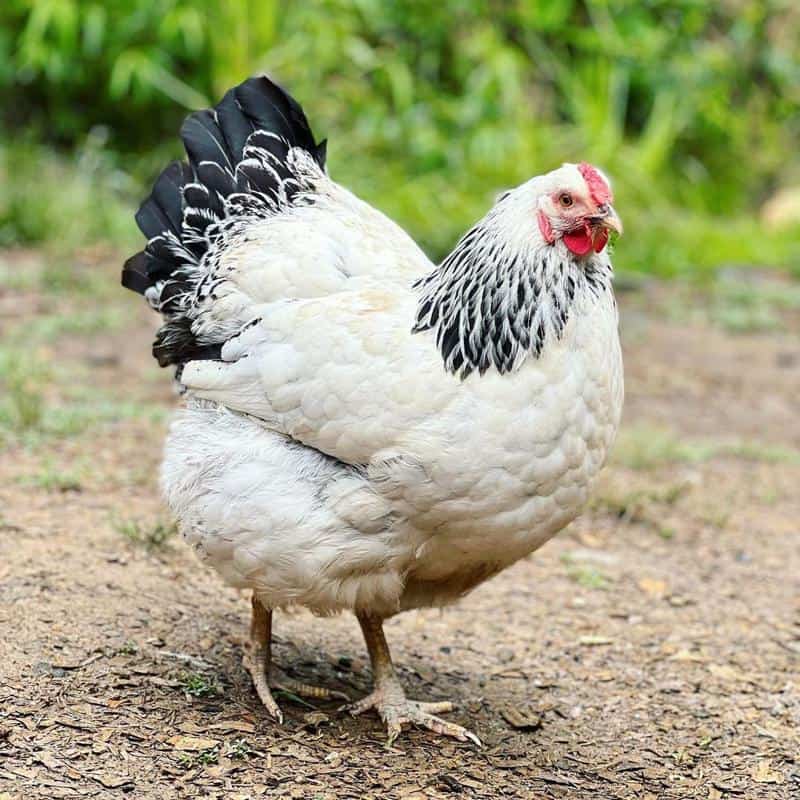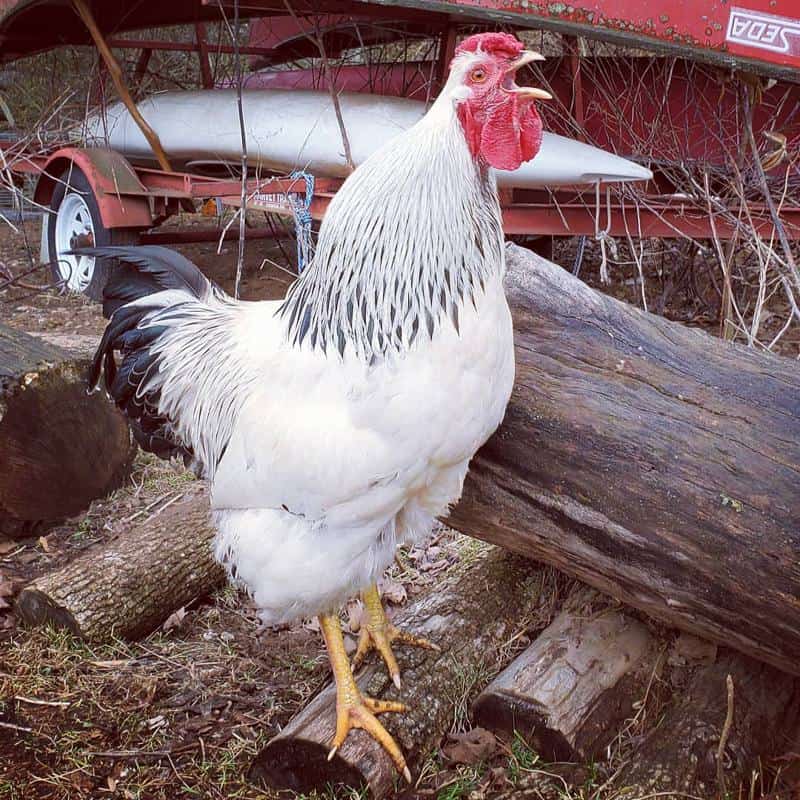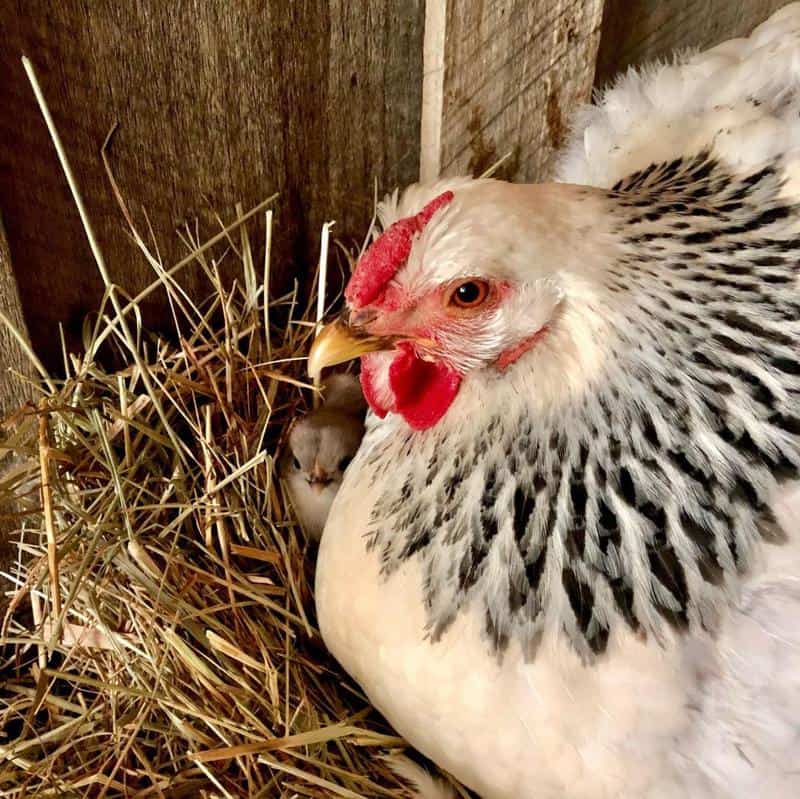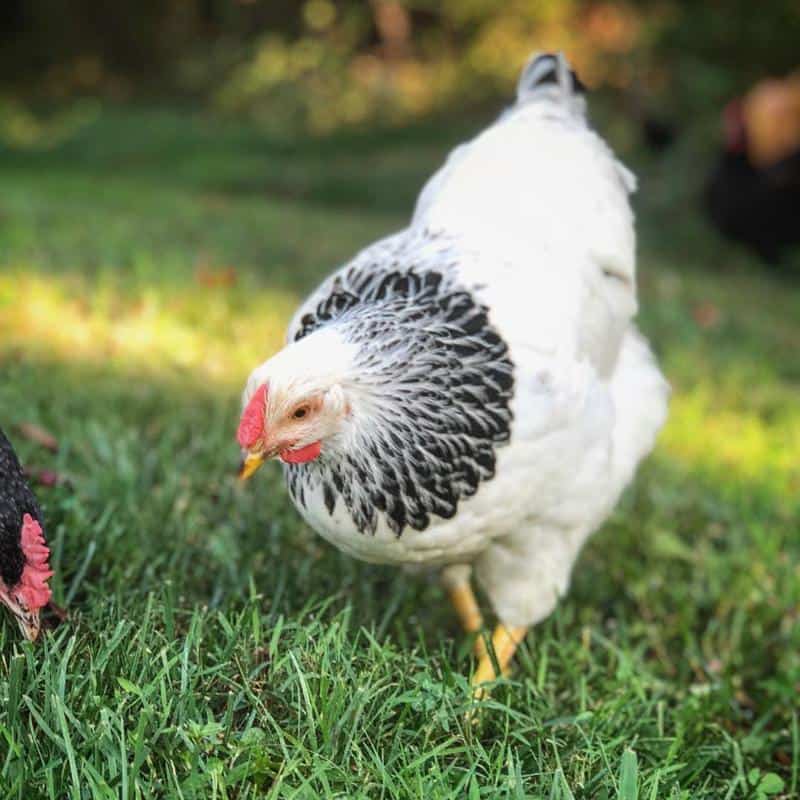You might have little or even deep knowledge of our feathery friends, but did you know there are over 1600 recognized chicken breeds worldwide? Well, that’s according to an article published by the FAO (Food and Agriculture Organization).
But amidst all these chicken kinds, only a few are commonly known, and Columbian Wyandotte is one such chicken breed — and for a good reason.
The Columbian Wyandotte is an American chicken breed featuring an excellent blend of personality and productivity, perhaps the reason its popularity amongst chicken keepers continues to skyrocket.

I mean, whether you’re a starter who’s just rolling out their chicken-keeping project or are an adept chicken keeper, there’s always something about the adorable Columbian Wyandotte that makes it a strong favorite for your home.
In this article, we’ll dive deeply into the ins and outs of the breed, clearly unearthing all there’s to know about these chickens. Right from their history and body size to their brooding inclination and feeding habits, there’s so much lined up for you today. So, let’s jump right in!
Columbian Wyandotte Chicken Quick Facts:
| Breed size | Fairly large |
| Weight | Roosters: 8 to 9 pounds
Hens: 6 to 7 pounds |
| Color of feathers | Mostly white with an intricate black lacing pattern around the neck and the wing tips, and perfectly complemented with a striking solid black tail. |
| Dual-purpose | Yes |
| Disposition | Docile, friendly, but curious |
| Number of eggs per year | 200 |
| Egg size | Medium to large |
| Egg color | Ranges from light brown with some slight pink tone to dark brown |
| Skin color | Yellow |
| Leg type | Clean |
| Leg color | Yellow |
| Color of the beak | Yellow |
| Comb type | Rose |
| Color of combs, wattles, and ear lobes | Bright red |
| Maturity | 6 to 7 months |
| Lifespan | 5 to 12 years |
| Broody | Less likely |
The History of The Columbian Wyandotte Chickens
The Columbian Wyandotte is one of the many types of the Wyandotte chicken, an American breed that was created in the 1870s.
The invention was done by four people — H. M. Doubleday, John Ray, L. Whittaker, and Fred Houdlette.
The breed’s name came from the Wyandot people, a North American native tribe, although they didn’t play a part in the breed’s creation.
The silver-laced, previously known as the Sebright Cochin or American Sebright before being included in the American Standard of Perfection in 1883, was the most common type of Wyandotte.
How the silver-laced variant was developed remains unclear to date, although the bird’s anatomy strongly suggests a possible connection with the dark Brahmas and spangled Hamburgs — Brahmas because of the color pattern, and Hamburgs for the short rose comb.
The Columbian variant, our primary focus today, emanated from a cross of the Barred Plymouth Rock and the white Wyandotte, a sport of the famous silver-laced variant. It got its name from the Columbian Exposition and World’s Fair that took place in Chicago in 1893.
Body Size & Appearance

Columbian Wyandotte is a fairly large bird that typically weighs between 6 and 9 pounds when mature, depending on whether it’s a roo or a hen. Usually, it’s the roos that will weigh more when fully grown, at about 8 to 9 pounds, while the hens typically get up to 7 pounds upon maturity.
A mature Columbian Wyandotte has a large, rounded body, with a flat back and massively-full breast.
The plumage is usually fluffy and solid white with an intricate black lacing pattern around the neck. As for the tail, it’s black with white lacing, while the white wing feathers finish up with black tips.
But that’s on mature Columbian Wyandottes. As chicks, this breed doesn’t differ much from other chicken breeds in appearance.
Usually, the chicks can be yellow, black, or a combination of yellow with black or gray feathering at the back. For the non-black chicks, you will also notice a small black patch on the head.
The yellow and black feathers slowly disappear as the bird grows, leaving the body covered mostly in white feathers at the pullet stage.
Although this chicken typically has a thick feathering, the legs are usually clean without any feathering on them. The color of the feet is usually yellow, which is also the color of their beaks and skin.
The eyes are typically reddish-orange, while the wattles, combs, and ear lobes are bright red.
The wattles are relatively long, especially in males, while their rose combs lie close to the head and are rather short, perfectly complementing the bird’s cold-hardy nature. As for the earlobes, they’re oval-shaped.
Also Read: Black and White Chickens Breeds
Temperament
Columbian Wyandotte chickens generally have a sweet temperament, perhaps the reason they’re becoming a popular backyard addition for chicken keepers. The birds are generally docile and friendly, making them a perfect go-to breed for starters and experienced chicken keepers alike.
But beware, intertwined with their friendliness and all other sweet attributes, is curiosity. Columbian Wyandotte chickens are a very curious breed!
And, well, for the most part, curiosity can be a good attribute for any creature to have — leave alone chickens. But with our feathered friends, the problem is that this aspect can easily sell them to predators, which really isn’t what any chicken parent would want.
As such, if you’re contemplating bringing Columbian Wyandotte into your flock, ensure they have a large secure space to roam around. It will keep the birds’ exploration instincts well covered, albeit without risking their safety.
Columbian Wyandotte Egg Production
Egg production was one of the reasons for the invention of the Columbian Wyandotte chicken breeds. Therefore, it’s one of the best layers if you’re looking for a breed to help you grow your egg numbers.
With this chicken breed, you can expect about 4 eggs a week, and that’s about 200 eggs a year. Well, that may not match the numbers of the Rhode Island Reds or even the Black Star, but it’s still a good yield, especially for a chicken not just made for eggs but also meat.
Also, like other chickens, egg production begins upon the hen reaching maturity, usually at around 6 to 7 months. Once it starts, it will continue until they’re 3 years, and then the laying frequency will diminish in some hens, while some maintain their exceptional egg-laying streak their whole life.
Furthermore, unlike some breeds whose egg yield drops when the temperatures begin to fall, Columbian Wyandottes keep on with the egg-laying routine even in winter, thanks to their thick plumage and short rose combs that keep them warm on extremely cold days.
As for the egg color, it can range from light brown, sometimes with a slight pink tone, to a dark brown color. And yes, the breed is much less broody than the average chicken, meaning you can list these chickens among the most reliable layers.
Broodiness
If you’re looking for a chicken breed to help enlarge your flock size, Columbian Wyandotte is definitely not what you need. As mentioned above, these chickens are usually not inclined to broodiness.
They can still get broody, especially when the conditions are supportive, but that just doesn’t happen very often, so they’re more suited for growing egg count than enlarging a flock size. But once they fall broody, these birds can make good moms after hatching.

Columbian Wyandottes are caring moms. But that’s not all — you might have also noticed that these birds breed true.
In other words, these docile chickens produce chicks that are genetically identical to themselves.
That’s why, similar to the mother; the chicks have yellow or black feathering or sometimes a combination of the two before they feather out.
Feeding
Like several other chicken breeds, Columbian Wyandottes are fantastic foragers. Hence, giving them enough space to forage for their food is one surefire way to keep them healthy and happy.
But on top of that, check to ensure your chickens get the ideal diet. The one-size-fits-all strategy doesn’t apply when it comes to feeding chickens. Hence, you should ideally adjust the diet depending on their development stage.
In other words, food meant for chicks may not be ideal for mature chickens and vice versa. For the former, offer a diet that contains at least 20% protein. This will help them build tissues and generally grow healthy.
However, once the birds reach 16 to 20 years, switch to a diet lower in protein. At this stage, protein isn’t as much-needed, so only ensure that they get about 16% of it in their food.
Once the hens approach the egg-laying stage, increase the amount of calcium in their food. You don’t have to offer them different food from the rest of the flock. Instead, you can use a separate container for calcium supplements like oyster shells or any other.
Egg shells are basically calcium carbonate, so the additional calcium goes into developing their egg shells. A hen getting enough calcium will lay healthy eggs that are less likely to break.
Housing

Chickens need proper housing, and Columbian Wyandottes are no exception. Give them plenty of room if you want a happy flock. Usually, each bird should have at least 4 to 6 square feet of space. If you can offer them more, that’s even better.
On top of the spacious coop, ensure your feathered friends have enough outside space to stretch their legs and scratch. That means they’re more suited for homes with reasonably-sized backyard space.
For the sake of the layers, get nesting boxes. They should be at least 12 inches by 12 inches to make them an attractive laying spot for the hens. Get as many as you think will be adequate, depending on the number of layers in your flock.
Columbian Wyandottes Price
The price of Columbian Wyandottes varies depending on where you’re buying them. But usually, you can expect a chick to cost you between $3 to $20.
When getting the chicks, it’s worth noting that, like most chicken breeds, Columbian Wyandottes are not autosexed.
That’s to say; you won’t be able to distinguish boys from girls until the chicks reach about 6 to 8 weeks, when secondary characteristics like comb development and feather growth become more apparent.
Health Problems
We don’t have specific health issues that target this breed. Generally, Columbian Wyandotte is a healthy breed that doesn’t require special treatment. However, it’s essential to ensure that your chickens get vaccinated and other basic forms of healthcare.
Also, since they have a very thick feathering, occasionally check the vent area to see if it might have accumulated droppings. You might want to trim the feathers around it to avoid any problem that may arise from them blocking the passage of droppings.
Again, their thick plumage means you must ensure the coop is well-ventilated. Otherwise, these chickens may find it difficult to cope with the hot temperatures of the summer.
On top of that, maintain the water bottle replenished. Replace it when necessary and ensure to sanitize it once in a while. If possible, keep it away from wild birds to avoid the spread of diseases.
Pros and Cons of Columbian Wyandotte Chicken Breed
If you’re still undecided as to whether the Columbian Wyandotte chicken breed is worth adding to your chicken population, having some knowledge of the pros and cons of having the breed might help.
Pros:
- Perfect temperament
- Dual-purpose chicken breed
- Breeds true
- Cold-hardy
- Not susceptible to particular health conditions
- Seasoned foragers
- Beginner-friendly
- Affordable chicks
Cons:
- Not autosexed
- Large space requirements
- The vent area requires occasional trimming
Read More:
Conclusion
Columbian Wyandotte is generally a lovely chicken breed to add to any backyard. These dual-purpose feathered friends have a sweet temperament and several other impressive qualities.
Just ensure to play your role well as their keeper if you want to keep them happy. That includes giving them a secure coop, enough space to roam, healthy food and clean water, and some tender love and care.
